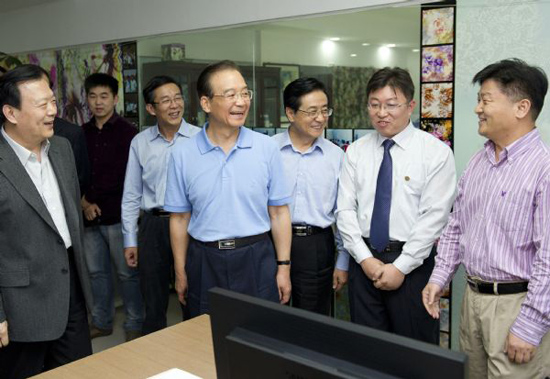
Beijing Battles Brewing Crisis in Financial Sector
Publication: China Brief Volume: 11 Issue: 19

Given that China is expected to contribute 24 percent of world growth this year, the fast-rising quasi-superpower is generally deemed a bastion of stability in the financial maelstrom that is hitting Europe and the United States. While Beijing, which is the largest holder of U.S. debt, has yet to make substantial purchases of the European bonds, it has expressed a theoretical willingness to help embattled EU countries. One of the goals of an upcoming session of the Chinese Communist Party’s (CCP) Central Committee is to project Chinese soft power by playing up the viability of the “China model.” Confidence in Beijing’s ability to manage China’s finances however has been shaken by a series of bad news about the nation’s private enterprises and its labyrinthine underground banking system.
Since early summer, thousands of once vibrant small and medium-sized enterprises (SMEs)—which account for more than half of China’s GDP and which create 80 percent of its jobs—have gone under. In Wenzhou, Zhejiang Province, the world-famous quasi-capitalist showcase, dozens of “red bosses” simply vanished last month without paying either their creditors or their employees. Wenzhou officials have increased visits to factories that appear to be in trouble with a view to forestalling mass layoffs should these firms fail. In the first seven months of the year, Wenzhou enterprises recorded losses of 640 million yuan ($100 million), or 220 million yuan ($34.5 million) more than 2010. While China’s private bosses are known for being savvy and resilient, many have turned from manufacturing—where labor and material costs are rising dramatically—to the much more lucrative business of speculating in the real estate market. The downturn in property and related sectors however means some of the most successful SMEs have gone bust. The so-called Wenzhou phenomenon is being duplicated elsewhere, including several cities in prosperous Guangdong Province (Wall Street Journal, October 1; Xinhua News Service, October 10; China News Service, August 26).
The financial disruptions hitting private firms is linked closely with the country’s gargantuan “underground banks.” These unlicensed lenders range from local-based businessmen’s cooperatives and brokers to credit and trust companies that are offshoots of official banks, insurance companies and other financial institutions. While illegal on paper, underground banks have been tolerated by the authorities for more than a decade. Even though China has given so-called “national treatment” to quite a number of foreign enterprises and joint-ventures, non-state firms routinely face discrimination from creditors. Most government-controlled banks, including the "Big Four"—Industrial and Commercial Bank of China, China Construction Bank, Bank of China and Agriculture Bank of China—prefer to do business with large state-owned enterprises (SOEs). Non-state companies, particularly SMEs, have for the past decade or so been forced to borrow from underground financial institutions. This is despite the fact that interest rates have been between 30 percent to 100 percent during the past year (Bloomberg, September 27; Global Times, September 30). Since Beijing tightened the official banks’ credit to the real estate sector early this year, underground banks have also become the prime financier to property developers. The shadow bankers have lent 208 billion yuan ($32.6 billion) to real estate companies so far this year, or nearly as much as the 211 billion yuan ($33.1 billion) worth of loans that official banks have extended to the sector. Estimates of the total size of China’s underground lending range from 4 trillion yuan to 8 trillion yuan ($627 billion to $1.3 trillion, respectively), or respectively around 8 percent to 16 percent of the official credit market (Reuters, September 23; Financial Times, October 6). It is obvious that a sudden downturn in the economy—such as a bursting of the housing bubble and domino-style defaults by borrowers—could wreak havoc on this shady banking industry.
Complicating the problem is the fact that many of the shadow financial institutions are so-called trust companies that are either directly or indirectly connected with either official banks or government-controlled business conglomerates. They have lured depositors by promising interest rates at least a few times higher than the meager 3.5 percent or so offered by official banks. Depositors have included SOEs as well as ordinary citizens, who have been transferring money from their saving accounts in official banks to underground ones. This partly explained the fact that deposits in the Big Four banks suddenly shrank by 420 billion yuan ($65.8 billion) in the first half of September. The extent of ordinary folks’ participation in the shadow banking sector is evidenced by the fact that 90 percent of Wenzhou residents have parked their money into these institutions. These underground lenders also are proving popular with depositors in neighboring Guangdong Province (Global Times, October 8; Reuters, September 22; Hong Kong Economic Journal, September 23; Asia Times, August 26).
Apart from giving loans to parties that have problem securing credit from government banks, trust companies and other underground financial institutions have repackaged and “securitized” their loans into asset-based securities and other wealth management products (WMP) that are similar to those dubious bonds and financial products that flooded the United States in the run-up to the sub-prime mortgage crisis in late 2008. The Chinese media have reported that commercial lenders issued 8.51 trillion yuan ($1.3 trillion) worth of WMPs in the first six months of this year, compared to about 7.05 trillion yuan ($1.1 trillion) for the whole of 2010 (South China Morning Post, September 26; Ming Pao [Hong Kong], September 27). The value of WMPs could shrink drastically at a time of economic fluctuations, leaving their investors with little compensation.
Meanwhile, the problem of bad loans being piled up by the nation’s close to 10,000 local-government financial vehicles (LGFV) remains unresolved. These semi-governmental institutions were set up by municipal- and grassroots-level administrations in 2008 and 2009 mainly to raise money for property and infrastructure development. The National Auditing Office estimated the LGFVs had amassed 10.7 trillion yuan ($1.7 trillion) of debt by the end of 2010. Yet independent estimates put the figure around 14 trillion yuan ($2.2 trillion) ("Local Debt Problems Highlight Weak Links in China’s Economic Model," China Brief, July 15). While the government anticipates that 2.5 trillion yuan to 3 trillion yuan ($392 billion to $470 billion) of these debts will turn sour, the U.S. rating agency Standard and Chartered reckons that as much as 8 trillion yuan to 9 trillion yuan ($1.3 trillion to $1.4 trillion) will not be repaid. A recent edition of the official Liaoning Daily said close to 85 percent of LGFV-related loans in northeast Liaoning Province missed debt service payments in 2010. Economist Cheng Siwei, who is a former vice chairman of the National People’s Congress, recently expressed worries about a mammoth debt crisis. “Our version of the U.S. sub-prime crisis is the lending to local governments, which is causing defaults,” Cheng said at the World Economic Forum in Dalian last summer (China Daily, September 17; Sina.com, September 17; Forbes, September 5).
Owing to the unmitigated spate of bad news on the finance front, it is not surprising that the stock prices of even the "Big Four" banks have tumbled by more than 30 percent since the summer. It is however premature to conclude the country is about to be plunged into a recession. While independent analysts estimate China’s total public debt is about 80 percent of GDP, central authorities still have a huge war chest. Central revenue was 8.3 trillion yuan ($1.3 trillion) last year. The country also holds more than $3.2 trillion in foreign-exchange reserves (Reuters, October 10; Ming Pao, September 29).
The central government’s apparent failure to take timely and efficacious action to combat the series of abuses however is a grave cause for concern. For example, despite repeated pledges by Premier Wen and Executive Vice Premier Li Keqiang about “rectifying dislocations” in the economy, very little has been done to curb the excesses of the underground banks or the LGFVs. Liu Mingkang, Chairman of the China Banking Regulatory Commission (CBRC)—which is the top watchdog of the banking industry—recently told the People’s Daily banks must "step up their prevention of risks associated with shadow banking." "The CBRC will strictly examine all financing products promoted by commercial banks to ensure that risk from these products will not extend into the banking system," Liu said. He also expressed confidence that debts incurred by LGFVs would not get out of hand. At a CBRC meeting earlier this year, Liu told bankers to "boost their investigation and research of the question of shadow banks, and to do well the task of following up [cases] and analysis" (Xinhua, August 17; China News Service, May 9). No decisive action however has yet been taken by either the CBRC or other government department to close down underground banks, trust companies or LGFVs.
After news of the massive defaults of Wenzhou enterprises hit the newsstands earlier this month, Premier Wen rushed to the city to give at least rhetorical support to the country’s struggling private sector. "Small enterprises should be a priority of bank credit support and they should enjoy more tax preferences from the government," said Wen. "Banks should increase their tolerance of the non-performing loan ratio of small enterprises, set targets for the expansion of loans to small companies and reduce the small businesses’ cost of securing credit" (CCTV, October 6; Xinhua, October 6). Given that it is a stated central-government policy to restrict lending—and to allow major commercial banks to give preference to SOEs in their credit policy—it is, however, unlikely Wen’s promises will materialize.
The central government is facing a tough dilemma. On the one hand, Beijing is unlikely to change its year-long policy of reining in credit so as to curb inflation—as well as excessive exuberance in the housing and other sectors. Last August, the consumer price index was 6.2 percent, slightly down from the three-year high rate of 6.5 percent recorded for July. Both officials and economists however have warned upward price spirals will continue for a relatively long period (BBC news, September 9; Reuters, September 24). On the other hand, the massive closure of SMEs means unemployment—and social unrest. Equally importantly, Beijing must do more to curtail reckless lending as well as the sale of WMPs in the shadow banking market. A massive failing of underground banks could lead to potentially violent protests by its tens of millions of depositors. China already suffers from more than 100,000 mass disturbances each year. Given that the 18th CCP Congress, which will witness a wholesale changing of the leadership, is just a year away, the current administration faces mounting pressure to clean up the country’s financial mess sooner rather than later.





